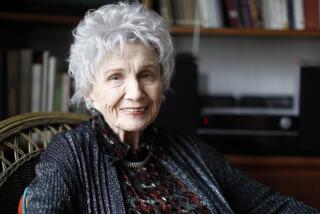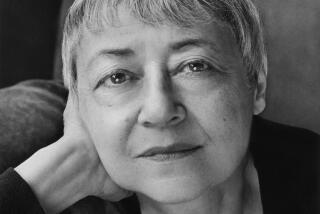The Early Prime of Miss Muriel Spark : CURRICULUM VITAE: Autobiography, <i> By Muriel Spark (Houghton Mifflin: $21.95; 213 pp.)</i>
- Share via
As if imagination alone were insufficient, every prolific novelist is eventually haunted by the question, “How much of your writing is autobiographical?” Scottish novelist Muriel Spark has avoided answering this question fully until now. “Curriculum Vitae” will delight fans as Spark points out the people and places in her life (remember “The Prime of Miss Jean Brodie”?) that she transmuted into her most unforgettable characters and settings.
Aside from a short piece about her childhood published in the New Yorker, little was known for certain of her private life. “For certain” is the operative phrase here, since the primary biographical sources--written by Spark’s one-time friend, Derek Stanford--have proven highly unreliable. Or, in Spark’s own words: “sheer guesswork, mythomania, invention” containing “a touch of the sniggering schoolboy, or of the gossip-columnist, that only scholars of equal leanings would seize on and elaborate.”
Near the conclusion of “Curriculum Vitae,” Spark writes, “I was too busy to raise my voice at the time. I said nothing then. I have said it now, this being the place.”
And she’s said it with a fine combination of intelligent grace and savage wit. If her memoirs are gospel--and she claims that she has written “nothing that cannot be supported by documentary evidence or by eyewitnesses”--then Spark was unusually generous in suffering the fools of this world prior to her 1957 ascension to literary fame and prosperity. In her memoirs, however, these fools simply suffer. Wielding invective like a scalpel, Spark proves that her skills as a satirist have been sorely underrated.
True to both her poetic nature and the psychological realism that is a mainstay of most of her fiction, Spark begins this account of her life in a fog of disconnected memories from her earliest childhood in Edinburgh in the early 1920s: a scene in a bakery run by a “floury bapper” and his “daft laddie”; a fascinating thread of memories about butter (bought at the Buttercup Dairy) intertwining childhood word games with vivid sense memories and a poem by R. L. Stevenson, also an Edinburgh native; the making and serving of tea, with all its precise etiquette.
This outpouring of charming cultural icons takes chronological form in 1923, when Muriel Camberg entered James Gillespie’s School. Here she spent 12 years--”the most formative years of my life,” she writes, “and in many ways the most fortunate for a future writer.” It was here that she “fell into” the hands of Miss Christina Kay.
“It might well be said,” Spark writes, “that she fell into my hands. Little did she know, little did I know, that she bore within her the seeds of the future Miss Jean Brodie. . . .”
“Seeds” is an understatement. From Spark’s description, there is very little difference between the real Miss Kay and the title character of “The Prime of Miss Jean Brodie.” Only the sexual innuendo of the novel seems imagined. Miss Kay even shared Miss Brodie’s penchant for prophesying the fates of “her girls.” According to Spark, “Miss Kay predicted my future as a writer in the most emphatic terms. I felt I had hardly much choice in the matter.”
Some readers will feel that the narrative here is more than a little bogged down in schoolgirl minutiae (Spark even includes excerpts from her science lab notes) yet from an educational perspective, all this becomes quite fascinating. Like Eudora Welty in “One Writer’s Beginnings,” Spark allows us to see the underpinnings of her creativity; and the insight is well worth the occasional lapse into solipsism.
“In order to write about life as I intended to do, I first felt I had to live,” Spark writes before plunging us into the next tumultuous period of her life. By the age of 19, in 1937, she found herself traveling alone to Southern Rhodesia, where she would marry Sydney Oswald Spark. The best reason she can muster for this disastrous marriage is that Sydney had brought her flowers when she had the flu. Thus one of her personal mottoes: Beware of men bearing flowers. As it turned out, “the poor man had mental problems,” and the white society of the place was unbearable. Compared with the “magnificent” Rhodesian blacks, “the conquering race looked as if it had only just emerged milk-fed from some nursery.” But Africa strengthened her, and gave her a taste for the exotic settings she used in numerous stories.
Trapped in Africa for most of World War II, Spark was desperate to return to England. She arrived in March, 1944, and was almost immediately put to work in the Foreign Office--specifically in political intelligence, MI 6, where she worked with Ian Fleming.
After the war, Spark began her literary apprenticeship in earnest, becoming the controversial editor of the rather mundane journal, Poetry Review, a publication wherein “Eliot, Pound, Auden had been dirty words.”
Her account of this fiery few months is wickedly hilarious, and a single exemplary encounter must suffice. One opponent of her poetics was Dr. Marie Stopes, an early expert on birth control. According to Spark, Stopes had lived with Lord Alfred Douglas, “the fatal lover of Oscar Wilde, an arrangement which I imagine would satisfy any woman’s craving for birth control.” Spark was “young and pretty,” whereas Stopes “had totally succumbed to the law of gravity without attempting to do a thing about it.” Many others suffer a similar fate at Spark’s hands, including a New York rare book dealer who, she claims, stole two volumes of her juvenilia from her apartment.
Spark ends her account in 1957, with her conversion to Catholicism and an intriguing sidelight about the composition of her first novel. Ten years after the war, food was still rationed in England, and Spark, the quintessential garreteer, was taking Dexedrine as an appetite suppressant. A four-month hallucination followed, involving an imagined code within the works of T. S. Eliot and the Greek dramatists, among others, which turned texts into cosmic anagrams. Upon her recuperation, Spark wrote “The Comforters,” in which a young critic hears voices dictating the actions of the characters in a novel that the protagonist of “The Comforters” must write.
“Curriculum Vitae” leaves us standing upon the threshold of Spark’s literary success, the tale of which, she says, “will be the subject of another volume.” No doubt it will have its own charm, but any story of success will be hard put to compare with this finely told story of intellectual and emotional struggle.
More to Read
Sign up for our Book Club newsletter
Get the latest news, events and more from the Los Angeles Times Book Club, and help us get L.A. reading and talking.
You may occasionally receive promotional content from the Los Angeles Times.










